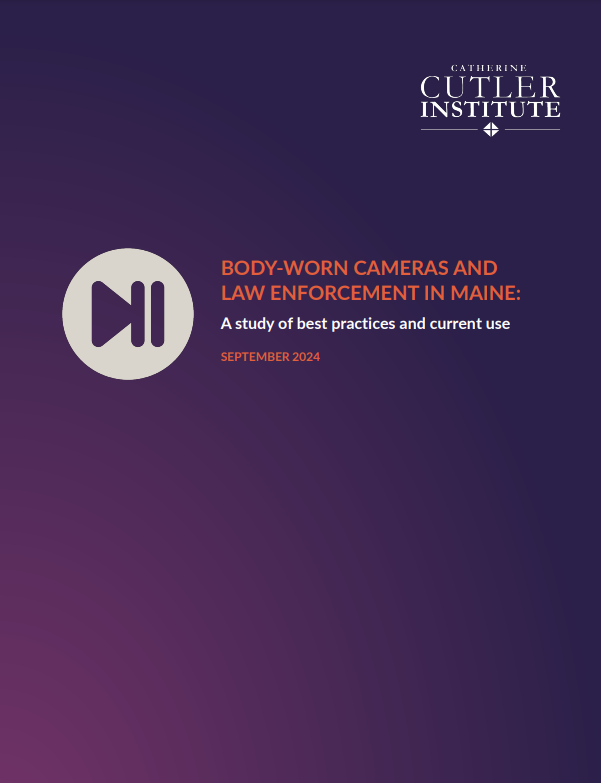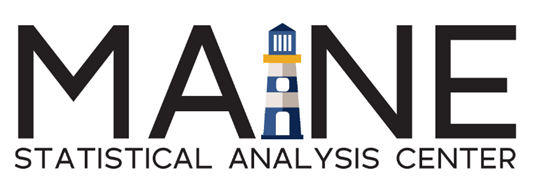Report
Body-Worn Cameras and Law Enforcement in Maine: A Study of Best Practices and Current Use
In Maine, local, state, and federal funding has enabled law enforcement agencies to purchase body-worn cameras (BWCs) and implement their use. Today, when high-profile events occur, there is often both an expectation that video footage exists and public pressure on law enforcement officials to release that footage. Civilians view the mere presence of a body-worn camera as the most important tool in the evaluation of allegations of use of force in police-civilian encounters.
At the request of the Attorney General of Maine, Aaron M. Frey, researchers at the Maine Statistical Analysis Center gathered current information on BWC use, policies, costs, and trends in Maine and explored nationally recognized best practices. Researchers surveyed all law enforcement departments (municipal, county, state, tribal, and university/college) statewide, with an overall response rate of 77%. They also interviewed a dozen justice system stakeholders, including law enforcement leaders from a variety of jurisdictions, geographic locations, and department size, as well as prosecutors and criminal defense attorneys, a member of the press, and community members with expertise in advocacy related to mental health, substance use disorder, racial justice, and domestic and sexual violence.
Key findings included that, as of January 2024:
- 70% of law enforcement agencies who responded to the survey were using BWCs;
- 21% of survey respondents were considering adding BWCs to their equipment;
- only 8% of those who responded indicated they were not considering BWCs;
- nearly two-thirds of respondents (65%) reported BWC-associated costs of $10,000 or less annually.
The study also found that the fiscal burden on smaller departments and municipalities is considerable. Estimating costs is complicated, since they depend on many variables such as the number of officers, cameras and docking systems, data storage, personnel to oversee, etc.
Still, the literature suggests that the benefits outweigh the cost in terms of greater public confidence/trust in law enforcement. Law enforcement leaders and key stakeholders in Maine also cited perceived benefits of BWCs. One leader called the cameras a “lifesaver,” because when a lawsuit is filed against his officers or agency, BWC footage can be used to resolve the dispute. The evidentiary benefits of BWC footage were noted by all of the stakeholders who were interviewed.

In addition to the challenges of funding BWC programs, the study highlighted some gaps and areas of inconsistency in Maine regarding current use of BWCs. For example, there is a lack of consistency and clarity regarding how long videos should be retained and when and how they should be released to comply with the state’s public records law. The report concludes with a list of recommendations to address gaps in legislation, strengthen existing BWC policy, and pursue potential BWC funding streams. A more detailed explanation of the recommendations can be found in the report.
Attorney General Frey summed up the study: “Body-worn cameras are widely supported by the public and are being utilized at higher rates than ever by law enforcement agencies. They are a critical tool in assessing equitable policing and ensuring public confidence in law enforcement. This study gives us a Maine-specific baseline to continue important conversations with law enforcement agencies, policymakers, and the public about improving our systems.”
Media Features
- County report: York County Sheriff’s Office deputies now wearing body cameras – Portland Press Herald – 12/2/2024
- Lack of body-worn cameras may be hindering domestic violence prosecution – WMTW – 10/2/2024
- Maine State Police roll out body cameras as technology becomes the norm across the state – WGME 13 – 9/26/2024
- Report: Use of body cams on the rise in Maine police departments – Spectrum News – 9/25/2024
- Attorney General Aaron M. Frey and the Catherine Cutler Institute at USM Issue Report on the Use of Body-Worn Cameras by Maine Law Enforcement – Office of the Maine Attorney General – 9/23/2024
- Body cameras becoming standard for Maine police agencies, new study finds – WGME 13 – 9/23/2024
- New study says body-worn cameras on the rise for law enforcement agencies in Maine – Maine Public – 9/23/2024
- Report examines body-worn camera usage among Maine law enforcement – Legal Newsline – 9/23/2024
- State shares insights on how body-worn cameras are used in Maine – News Center Maine – 9/23/2024
- 8 Investigates: More Maine police departments are using body-worn cameras, some say it’s too expensive – WMTW – 9/24/2024
- 70% of Maine Police Departments Use Body-Worn Cameras, 21% Are Considering It: MSAC Report – Maine Wire – 9/24/2024
- More Maine police departments are using body-worn cameras, some say it’s too expensive – WABI – 9/25/2024
- Study shows body camera use expanding among Maine law enforcement, but policies not keeping up – 9/25/2024 – News From The States
